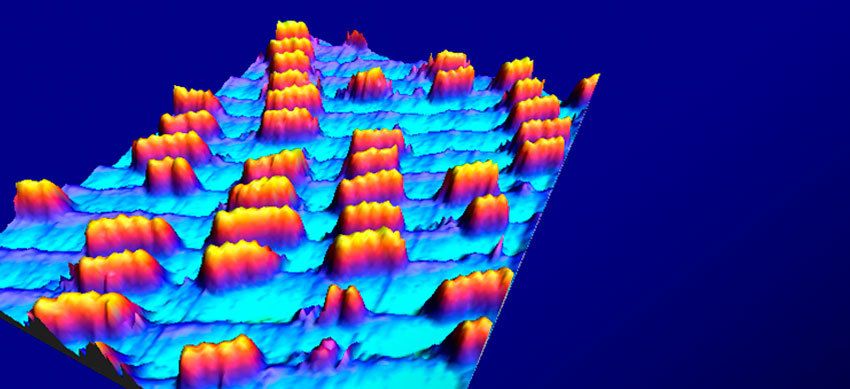CHEMICAL PHYSICS OF COMPLEX MATERIALS

The research line on “Chemical Physics of Complex Materials” addresses the structural and electronic properties of complex nanostructured materials. Experimental and theoretical efforts are combined to understand the properties, formation, and dynamics of different molecules and nanostructures at surfaces.
Several research groups are included in this research line, with a high degree of complementarity.
THE RESEARCH GROUPS
GAS/SOLID INTERFACES
The “Gas/Solid Interfaces” group focuses on the atomic-level understanding of physical and chemical processes arising at the interface between gas and solid phases of matter. The understanding of these elementary reactive and non-reactive processes is crucial in many energy- and environmental-related applications, including heterogeneous catalysis, electrochemistry, hydrogen storage, and fusion reactors. The activity of the “Gas/Solid Interfaces” group relies on the development of new methodologies as well as on the use of first-principles electronic structure calculations to describe the interaction dynamics in such complex systems. Particular attention is paid to the development of theoretical models able to describe the non-adiabatic contributions and the energy dissipation channels that come into play, because they can drastically change the output of the dynamics. Current research in the group also includes methodological advance in the simulation and analysis of photo-induced adsorbate dynamics and reactions, as well as the use of machine learning strategies specifically adapted to study the gas/solid interface dynamics.
QUANTUM PHENOMENA ON SURFACES
The group studies theoretically and experimentally exotic phenoma taking place on solid surfaces. These phenomena range from the creation of Majorana fermions, to the study of skyrmions or the creation of entangled states among many studies. Model Hamiltonians are interfaced to ab-initio calculations and the physics is explored with the aim of learning about the systems to understand phenomena and eventually predict them. Experimentally, the scanning tunneling microscope allows us to have atomic control on the studied systems and create structures that can show Majorana fermions on superconductors or display entangled atoms in the Kondo effect of spin chains, for example.
NANOPHYSICS LABORATORY
“Nanophysics Laboratory”, devoted to the experimental characterization of surfaces, low-dimensional systems, and novel nanostructured materiales prepared using a surface science approach and studied using scanning tunnelling (STM), atomic force microscopy (AFM), several photoemission (XPS, ARPES, UPS) and absorption (NEXAFS) techniques, among others. The laboratory aims to provide the complete structural and electronic characterization of nanostructured systems with atomic resolution. Special attention is given to self-assembled nanostructures like stepped surfaces and supramolecular assemblies. It is also worth to mention activity on curved crystals that has given rise to the development of a spin-off company, namely “Bihurcrystal“.
MODELISATION AND SIMULATION
The activity of the “Modelisation and Simulation” group focuses on the theoretical study of the electronic and structural properties of complex materials, clean and decorated surfaces, and nanostructures. It pursues the following objectives: (i) to develop the basic theory and ab-initio simulation tools in order to study the behavior of different nanoelectronic devices, particularly those based on graphene derivatives, (ii) to study the optical properties of complex organic/inorganic interfaces, (iii) to study the magnetic properties of different nanostructures, ranging from one dimensional systems to coordination networks and multilayer heterostructures at surfaces, and (iv) to continue to foster the development of the SIESTA code. Most of the research activity of this group is performed in close collaboration with other experimental and theoretical groups at CFM, and also with groups from other research centers in the Basque Country.
SPECTROSCOPY AT THE ATOMIC SCALE
“Spectroscopy at the atomic scale” group, devoted to structural and spectroscopical investigations at the local scale, based on scanning tunneling techniques. Electronic, vibrational, and transport properties at surfaces are addressed. The group’s main tool for studying nanostructures at the atomic scale is low temperature scanning probe microscopy. Local properties of nanoscale objects and surfaces are thus probed in ultra-high vacuum and at temperatures down to 1K.
RESEARCH FACILITIES
A combined AFM/STM instrument capable of scanning atomic forces and tunneling current simultaneously at 1 K.
A combined ARPES/STM system with a double prep-chamber, which permits separate and joint ARPES/STM experiments. The ARPES chamber is an ultra-high resolution (0.1 degree, 5 meV) system, able of measuring solid samples down to 20 K.
Two separate STM/X Ray Photoemission (XPS) and STM/Magneto Optic Kerr Effect (MOKE) chambers for surface chemistry and surface magnetism experiments, respectively.
Several computing clusters at CFM and other institutions (such as DIPC) under collaborative research. Several scientific codes for ab initio calculations (DFT based on plane waves and local orbitals, quantum chemistry, quantum Monte Carlo), as well as other computational and graphic packages.
Development of scientific software for ab initio calculations as well as for other methodologies, including packages freely distributed to the scientific community (e.g., the SIESTA code developed in collaboration with other institutions).



